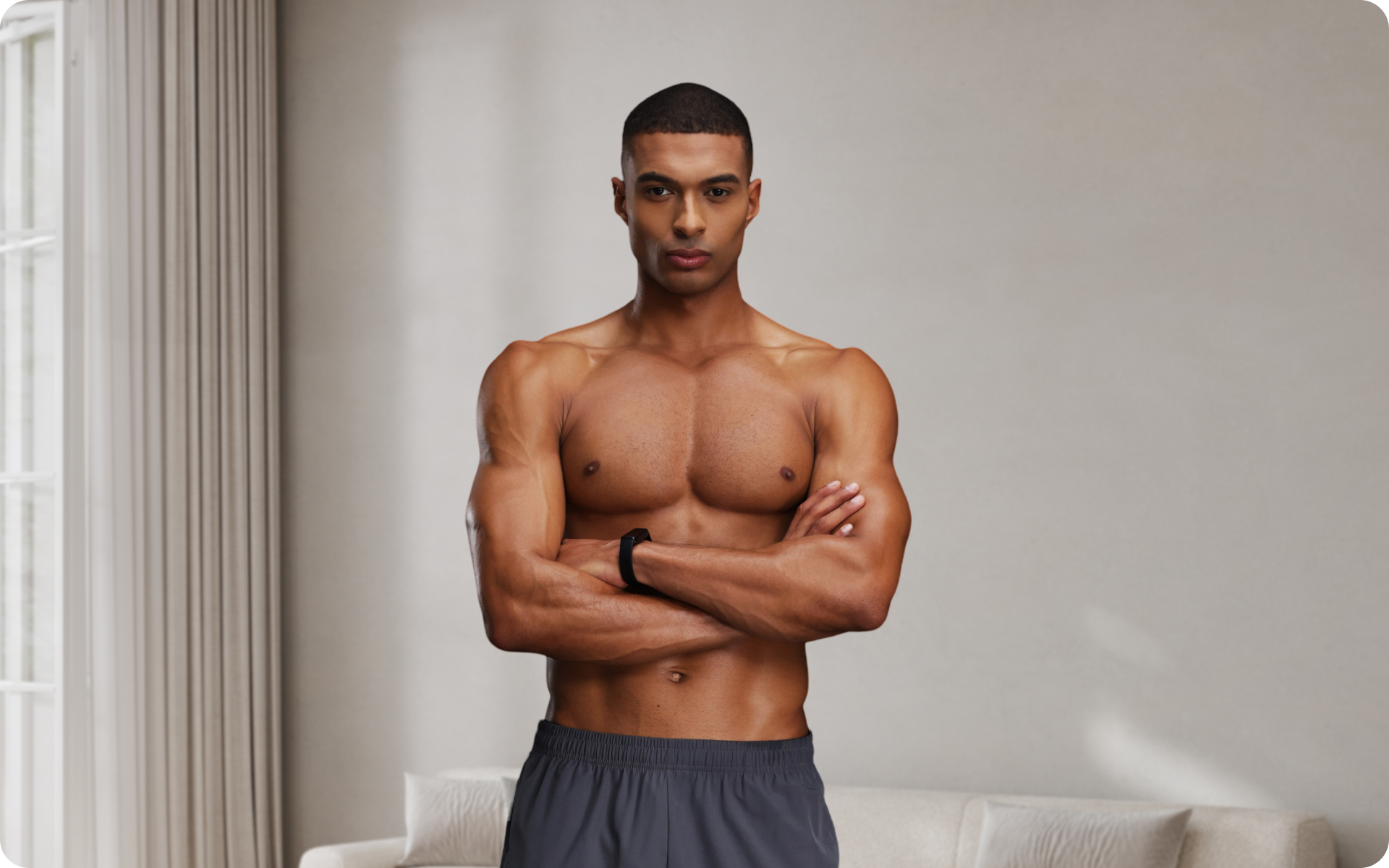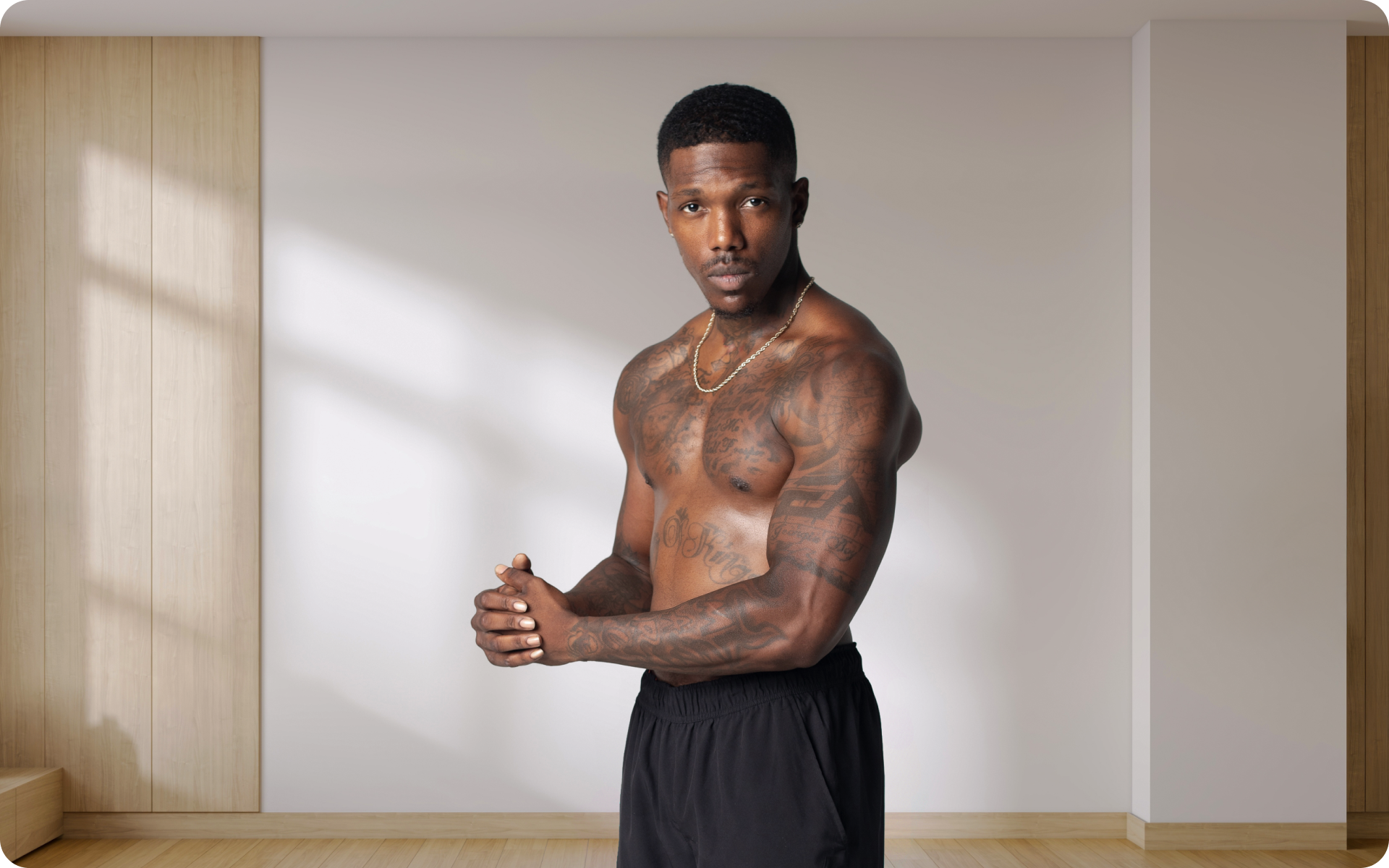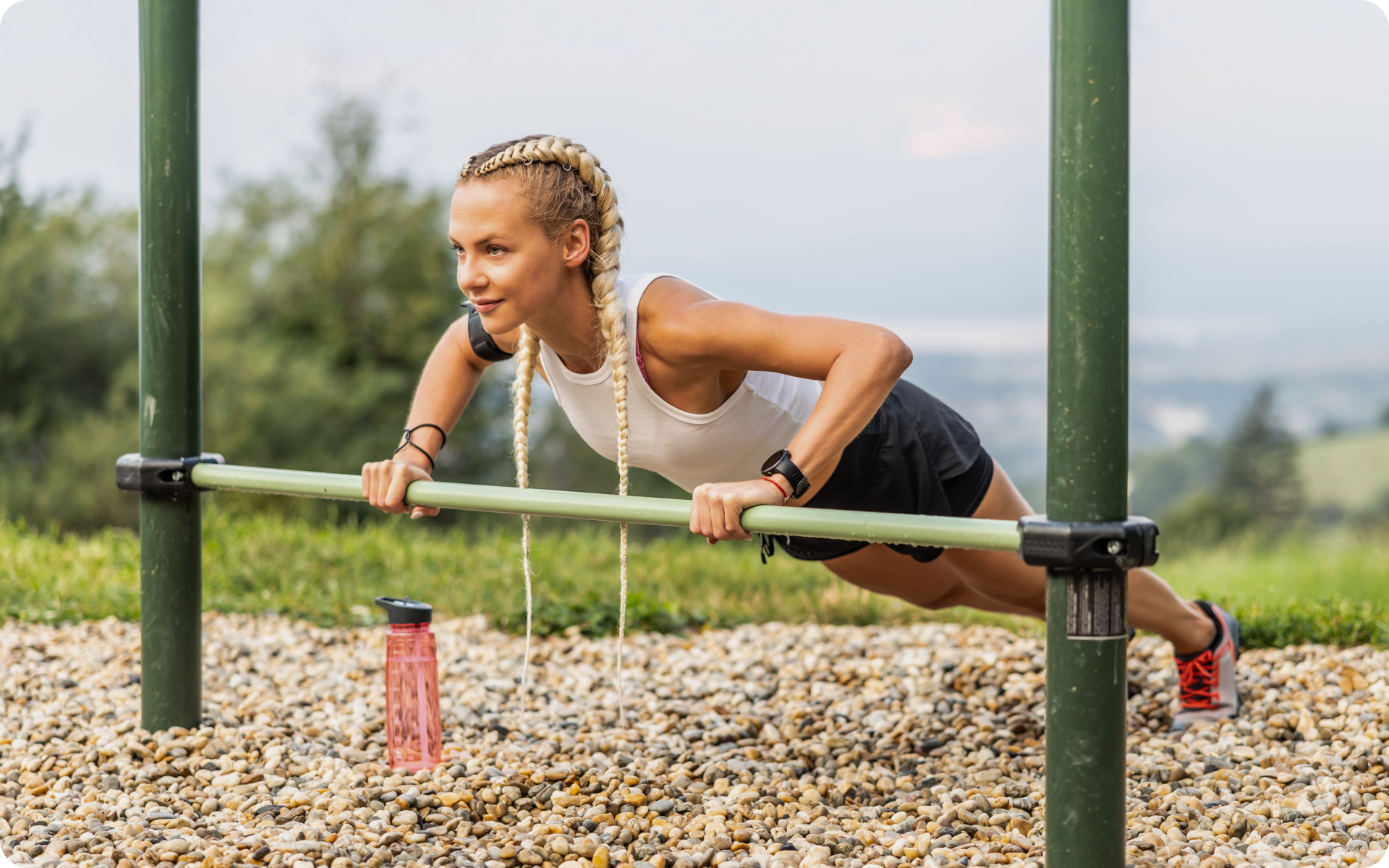Core calisthenics sounds like a term reserved for lean, mean athletes. In reality, it’s one of the most effective methods for sculpting your body, and you don’t have to have a gym membership.
Core calisthenics requires you to use your body weight as resistance, meaning you can do these exercises anywhere, anytime.
By strengthening your core, you support better posture, reduce the risk of injury, and improve your overall fitness level. You may even get better at other physical activities, from running to lifting weights, because a strong core is central to both power and endurance (3).
Here’s a look at some of the most effective calisthenics exercises to kickstart your journey toward achieving a toned and defined abdominal area.
Do Calisthenics Build Abs?
Core calisthenics for beginners engages multiple muscle groups at once, including your rectus abdominis, obliques, and transversus abdominis. As a result, these exercises can effectively strengthen and tone your core.
That said, the secret to visible abs is not just by working out but also by maintaining a healthy diet and reducing overall body fat.
While performing your core calisthenics exercises at home, pay some attention to what and how much you’re eating. Incorporate plenty of protein-rich foods and healthy fats, while limiting processed sugars and unhealthy snacks (2). This will help you reach your desired body composition faster.
Our How to Lose Belly Fat Overnight article provides more insight on this.
Yanking yourself back in shape has never been so easy with our game-changing fitness app! Start transforming your life with BetterMe!
8 Exercises for Your Calisthenics Core Workout Plan
You can perform a calisthenics core workout with no equipment required, using just your body weight. The following exercises target different areas of your core, from your upper abs to your lower abs and obliques.
1. Forearm Plank
The Forearm Plank is a potent exercise for core stabilization, engaging multiple muscle groups simultaneously. It primarily targets the rectus abdominis, obliques, and transverse abdominis, which are crucial for maintaining good posture and supporting the spine. By also engaging the shoulders, chest, and glutes, this exercise helps develop overall body strength.
How to Perform a Forearm Plank:
- Begin by lying face down on the floor with your forearms flat and elbows aligned below your shoulders.
- Engage your core and raise your body off the floor, maintaining a straight line from your head to your heels.
- Keep your gaze down to avoid neck strain and breathe steadily.
- Hold the position as long as you can maintain proper form, aiming for 30 seconds to begin with and then increasing the time as you get stronger.
2. Hollow Body Crunch
The Hollow Body Crunch targets the entire core, with a particular emphasis on the deep abdominal muscles. This exercise is crucial for improving the body’s ability to perform dynamic movements and enhances stability and balance.
How to Perform a Hollow Body Crunch:
- Lie on your back with your arms stretched overhead and legs extended.
- Engage your core and lift your shoulders and legs off the floor, creating a “banana” shape with your body.
- Hold for a moment at the peak of the crunch, then slowly lower back down without letting your limbs touch the floor.
- Repeat for 10-15 reps, focusing on maintaining tension in your core throughout the movement.
3. Hanging Knee Raises
Hanging Knee Raises primarily work the rectus abdominis and hip flexors, but they also engage the obliques. This exercise is excellent for developing core strength and improving muscular definition.
How to Perform Hanging Knee Raises:
- Begin by hanging from a pull-up bar with your hands shoulder-width apart and arms fully extended.
- Keeping your lower back straight, engage your core and raise your knees towards your chest.
- Slowly lower your knees back to the starting position, maintaining control throughout the movement.
- Perform 10-15 reps, ensuring you’re not swinging to generate momentum.
4. Calisthenic L-sit
The L-sit is a highly challenging exercise that targets the core, specifically the rectus abdominis, obliques, and hip flexors. This exercise not only strengthens the core but also improves endurance and stability, making it beneficial for both beginners and advanced athletes.
How to Perform a Calisthenic L-sit:
- Sit on the floor with your legs extended in front of you and your hands placed on the floor beside your hips.
- Press down into your hands, engaging your core and lifting your hips and legs off the floor.
- Try to keep your legs straight and lifted, forming an “L” shape with your body.
- Hold this position for as long as you can maintain proper form, aiming for 10-20 seconds to start.
- Lower your body back to the starting position and repeat for 2-3 sets.
5. Ab V-Hold
The Ab V-Hold, also known as the V-Sit, targets the entire abdominal region, including the rectus abdominis and obliques. It is an excellent exercise for improving core stability and enhancing balance.
How to Perform an Ab V-Hold:
- Begin by sitting on the floor with your knees bent and feet flat.
- Lean back slightly, engage your core, and lift your feet off the floor, extending your legs so your body forms a V shape.
- Extend your arms straight forward or for an added challenge, elevate them towards your shins.
- Hold this position, focusing on balancing and maintaining tension in the core, for 15-30 seconds.
- Slowly return to the starting position and repeat for 3-4 sets.
6. Butterfly Crunch
The Butterfly Crunch targets the core muscles, specifically the rectus abdominis and obliques. It also engages the hip flexors and improves flexibility in the hips and lower back.
How to Perform a Butterfly Crunch:
- Sit on the floor with the soles of your feet together and your knees dropped out to the sides, creating a butterfly position with your legs.
- Lay your back on the floor with hands behind your head.
- Engage your core and crunch up bringing your shoulder blades off the floor.
- Pause at the top focusing on keeping your core engaged before returning to the starting position.
- Repeat for 10-15 reps, 2-3 sets.
Read more: The Simplest Lower Back Calisthenics Guide for Beginners
7. Half-Kneeling Wood Chop
The Half-Kneeling Wood Chop is an excellent exercise for enhancing rotational strength and improving core stability. It specifically targets the obliques, rectus abdominis, and transverse abdominis, which are crucial for rotational movements and overall core function. Additionally, it engages the shoulders and glutes, providing a comprehensive workout that aids in functional movements and supports spine health.
How to Perform a Half-Kneeling Wood Chop:
- Start in a half-kneeling position with your right knee up and left knee on the ground. Make sure your right foot is flat on the floor, and your left knee is directly beneath your hip.
- Hold your hands together (or hold a weight for added resistance) and extend them to the left side of your body, close to the floor beside your left knee.
- Engage your core and rotate your torso as you lift your hands diagonally across your body to the right side, extending them above your right shoulder.
- Slowly reverse the motion, bringing your hands back down to the starting position.
- Perform 10-12 reps on one side, then switch to the other side, making sure that you maintain a tight core and controlled movements throughout the exercise.
8. Dead Bug
The Dead Bug exercise is fundamental for building core strength, particularly in the rectus abdominis and transversus abdominis. This movement also engages the hip flexors, stabilizing the spine and pelvis. Its primary function is to enhance core stability, which is vital for everyday movements and athletic performance.
How to Perform a Dead Bug:
- Lie on your back on the floor with your arms extended towards the ceiling directly above your shoulders.
- Lift your legs, bending at the knees to create a 90-degree angle.
- Engage your core by pressing your lower back into the floor, making sure there’s no space between your back and the floor.
- Slowly lower your right arm and left leg towards the floor, keeping them straight and stopping just before they touch the ground.
- Return to the starting position and alternate sides, lowering your left arm and right leg.
- Continue alternating sides for 10-15 reps on each side, focusing on keeping your core engaged and your movements controlled.
Our guide: 4 Best Core Exercises for Beginners has simpler exercises to help you build a strong core and improve your overall fitness.
If you wish to cinch your waist, tone up your bat wings, blast away the muffin top – our fitness app was created to cater to all your needs! BetterMe won’t give excess weight a chance!
How To Start Calisthenics?
To start calisthenics, you must learn the foundation movements and techniques, build strength and endurance gradually, and progress to more challenging exercises.
The Foundational Movements
The foundational movements in calisthenics involve bodyweight exercises that target different muscle groups and promote functional strength (1). These movements include push-ups, pull-ups, squats, lunges, and planks.
Each of these exercises has variations that can be modified to suit your fitness level, making them suitable for beginners and advanced athletes alike.
Building Strength and Endurance
As with any form of exercise, it’s essential to start slowly and focus on proper form rather than quantity. Begin with the basic variations of each exercise and aim for 10-12 repetitions per set. As you progress, you can increase the number of sets and repetitions or move on to more advanced variations (4).
It’s also crucial to give your body enough time to rest and recover between workouts. This allows your muscles to repair and grow stronger, preventing injury and promoting progress.
Read more: Calisthenics Shoulder Exercises: Techniques and Workouts
Progressing in Calisthenics
One of the most exciting aspects of calisthenics is its endless potential for growth and progress. As you master the foundational movements, you can challenge yourself with more advanced variations or incorporate additional exercises into your routine (4).
You can also focus on specific goals, such as improving strength, endurance, or flexibility, and adjust your workouts accordingly. The key is to continue pushing yourself out of your comfort zone while maintaining proper form.
Our, calisthenics back workout blog has advanced exercises you can try.
FAQs
Is Core Important for Calisthenics?
Core strength is crucial for calisthenics as it provides a stable and strong foundation for all movements. A strong core also helps prevent injury, improves posture and balance, and enhances overall athletic performance (3). Therefore, incorporating core exercises into your calisthenics routine is essential for progress and success in the sport.
Does Planche Use Core?
Yes, the Planche exercise relies heavily on core strength as it requires you to hold your body in a horizontal position with only your hands touching the ground.
This engages the entire core, including the rectus abdominis and transversus abdominis, in order to stabilize and maintain this challenging position. Therefore, developing strong core muscles is crucial for achieving the Planche in calisthenics.
Do You Need Abs for Planche?
Having strong core muscles, including the rectus abdominis and transverse abdominis, is essential for achieving a Planche. However, it’s not necessary to have defined abs or a six-pack to perform this exercise successfully.
Building strength and stability in your core through various exercises, such as planks and leg raises, can help you progress towards mastering the Planche over time.
How Do I Strengthen My Core for Planche?
To strengthen your core for Planche, you can incorporate exercises such as planche leans, hollow body holds and L-sits into your calisthenics routine. Focusing on proper form and gradually progressing to more challenging variations will help build the necessary strength and stability.
Why Is Planche So Hard?
The Planche is a challenging exercise because it requires an immense amount of upper body and core strength, as well as balance and proper form. It’s considered an advanced calisthenics movement that takes time and dedication to master.
You may struggle with the Planche initially, but with consistent practice and progression you can eventually achieve this impressive feat.
How To Do a Butterfly Hold Calisthenics?
To perform a butterfly hold in calisthenics, follow these steps:
- Sit on the floor with your feet together and knees dropped out to the sides, creating a butterfly position with your legs.
- Lean back slightly and place your hands behind you for support.
- Engage your core and lift your feet off the ground, bringing your knees closer to your chest.
- Hold this position for 20-30 seconds, focusing on keeping your core tight and maintaining balance.
- Slowly lower your feet back to the ground and repeat for 2-3 sets.
The Bottom Line
Core calisthenics is the answer to building a strong and functional core while improving your overall fitness. By mastering the foundational movements, gradually building strength and endurance, and continually challenging yourself you can progress in calisthenics and achieve impressive feats like the Planche.
DISCLAIMER:
This article is intended for general informational purposes only and does not serve to address individual circumstances. It is not a substitute for professional advice or help and should not be relied on for making any kind of decision-making. Any action taken as a direct or indirect result of the information in this article is entirely at your own risk and is your sole responsibility.
BetterMe, its content staff, and its medical advisors accept no responsibility for inaccuracies, errors, misstatements, inconsistencies, or omissions and specifically disclaim any liability, loss or risk, personal, professional or otherwise, which may be incurred as a consequence, directly or indirectly, of the use and/or application of any content.
You should always seek the advice of your physician or other qualified health provider with any questions you may have regarding a medical condition or your specific situation. Never disregard professional medical advice or delay seeking it because of BetterMe content. If you suspect or think you may have a medical emergency, call your doctor.
SOURCES:
- Build a Strong Foundation with Functional Strength Training (n,d,usu.edu)
- Editorial: Nutritional Strategies to Promote Muscle Mass and Function Across the Health Span (2020,nih.gov)
- The real-world benefits of strengthening your core (2012,harvard.edu)
- What is a progressive overload workout plan? (2022,medicalnewstoday.com)










